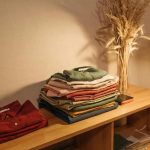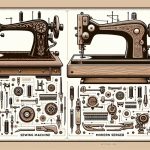You’ll want to choose a strong, durable thread like heavy-duty cotton-wrapped polyester or bonded nylon for upholstery. These threads resist abrasion, stretch slightly with fabric movement, and maintain colorfastness—perfect for furniture that sees regular use. Avoid weak options like cotton or lightweight threads that can snap easily. Matching the thread’s strength and material to your fabric guarantees long-lasting seams and a professional look. Keep going to discover how to pick the best size and specialty threads for your project.
Table of Contents
Key Takeaways
- Use heavy-duty cotton-wrapped polyester or bonded nylon thread for strength, durability, and abrasion resistance in upholstery projects.
- Choose thread with colorfastness and UV resistance, especially polyester, to prevent fading and maintain appearance after cleaning.
- Match thread type and strength to fabric fiber content for optimal durability and a professional finish.
- Select medium to heavy-duty thread sizes (Tex 40 to Tex 70) to ensure strong seams without puckering or bulkiness.
- Avoid weak threads like cotton-only, lightweight polyester, or embroidery thread that can snap or degrade under heavy use.
Characteristics of Upholstery Thread
Although you might overlook it, choosing the right upholstery thread is essential because it directly affects the durability and appearance of your furniture. You want a thread that’s strong enough to handle constant use without snapping or fraying.
It also needs to resist abrasion since upholstery faces regular wear and tear. Flexibility is key too; your thread should move with the fabric, preventing stiffness or puckering.
Don’t forget colorfastness—your thread should maintain its color without fading or bleeding, even after cleaning.
Finally, consider the thread’s resistance to sunlight and moisture, especially if your furniture is near windows or in humid areas. Keeping these characteristics in mind will help you pick a thread that holds up well and complements your upholstery perfectly.
Types of Thread Suitable for Upholstery
When selecting thread for upholstery, you’ll find several types designed to meet different needs and fabrics. Heavy-duty cotton-wrapped polyester thread offers strength and durability, making it ideal for natural and synthetic upholstery fabrics.
Heavy-duty cotton-wrapped polyester thread provides the perfect blend of strength and durability for upholstery fabrics.
Bonded nylon thread is another excellent choice; it resists abrasion and stretches slightly, helping seams withstand stress. For projects requiring extra toughness, Kevlar thread provides superior heat and cut resistance, perfect for high-use furniture.
You might also consider silk thread for delicate or antique upholstery, as it combines strength with a smooth finish. Ultimately, matching the thread to your fabric type and the furniture’s use guarantees your upholstery lasts longer and looks professional.
Always choose a thread that balances strength, flexibility, and compatibility with your material.
Comparing Polyester and Nylon Threads
Anyone choosing between polyester and nylon threads will find distinct advantages in each, depending on the project’s demands.
Polyester thread offers excellent UV resistance and colorfastness, making it ideal for upholstery exposed to sunlight. It’s also strong, slightly stretchy, and resists abrasion well, so it holds up under regular use.
Nylon thread, on the other hand, boasts superior elasticity and exceptional strength, which makes it great for heavy-duty applications where materials might shift or stretch. However, nylon tends to degrade faster in prolonged sunlight exposure.
Both threads are compatible with most upholstery fabrics, but polyester generally outperforms nylon in durability for indoor use.
When deciding, consider where your upholstery will live—choose polyester for sun-exposed areas and nylon if flexibility and extra strength are your priorities.
Specialty Threads for Heavy-Duty Upholstery
Because heavy-duty upholstery demands exceptional strength and durability, specialty threads are your best bet for long-lasting results. These threads resist abrasion, UV rays, and moisture better than standard options. For tough jobs, look for bonded nylon or bonded polyester—they offer superior tensile strength and won’t easily fray or break under stress. Kevlar thread is another excellent choice, especially if you need extreme durability and heat resistance. Below is a quick comparison to help you decide:
| Thread Type | Key Features |
|---|---|
| Bonded Nylon | Strong, abrasion-resistant, flexible |
| Bonded Polyester | UV and moisture-resistant, durable |
| Kevlar | Heat-resistant, extremely strong |
Choosing specialty threads guarantees your upholstery withstands heavy use and maintains its integrity over time.
Choosing the Right Thread Size and Strength
You’ll want to pick a thread size that fits your fabric to guarantee strong seams without bulk.
Using a thread with the right strength keeps your upholstery durable through daily use.
Matching thread strength and size to your fabric helps your project hold up and look professional.
Thread Size Importance
When selecting thread for upholstery, choosing the right size and strength is essential to secure durability and appearance.
Thread size affects how well your stitches hold fabric pieces together without puckering or breaking. If the thread is too thin, it might snap under tension or wear out quickly. Conversely, a thread that’s too thick can create bulky seams and damage delicate fabrics.
Typically, upholstery projects call for a medium to heavy-duty thread size, such as Tex 40 to Tex 70, balancing strength and flexibility. Always match your thread size to the fabric weight and type to guarantee smooth stitching and a professional finish.
Paying attention to thread size helps your upholstery withstand daily use while maintaining a clean, attractive look.
Strength for Durability
Selecting the right thread size lays the groundwork, but strength plays an equally important role in upholstery durability. You want a thread that can withstand everyday wear and tear without snapping or fraying.
Look for heavy-duty threads made from polyester or nylon, as they offer excellent tensile strength and resistance to abrasion. Thicker threads generally provide more durability, but avoid going too heavy, which might create bulky seams or damage the fabric.
It’s crucial to balance strength with flexibility so the thread can move with the upholstery without breaking. Always consider the stress your project will endure—high-traffic furniture demands stronger thread.
Matching Thread to Fabric
Although strength and size are important individually, matching thread to fabric guarantees your upholstery holds together seamlessly.
When you select thread that complements your fabric’s weight and texture, your project stays durable and looks professional. Using too thick a thread on lightweight fabric can cause puckering, while too thin a thread on heavy fabric may break under stress.
Consider these factors when choosing thread:
- Fiber compatibility (polyester thread for synthetic fabrics)
- Thread size relative to fabric weight
- Thread strength for heavy-duty use
- Color matching to blend or contrast
- Texture smoothness to avoid fabric damage
Tips for Sewing Upholstery With Durable Thread
Since upholstery undergoes constant wear and tear, you’ll want to use a thread that can stand up to heavy use without breaking or fraying. Choose a heavy-duty polyester or nylon thread for strength. Use a larger needle and adjust your sewing machine tension to prevent skipped stitches. Always test your thread and fabric combo on a scrap piece first.
| Tip | Why It Matters |
|---|---|
| Use heavy-duty thread | Guarantees durability and strength |
| Adjust machine tension | Prevents thread breakage |
| Test on fabric scrap first | Avoids surprises during sewing |
Following these tips helps you create upholstery that lasts, maintaining both form and function.
Common Mistakes to Avoid When Selecting Upholstery Thread
Don’t choose a weak thread that won’t hold up under pressure, or your upholstery could fall apart quickly.
Make sure the thread material matches your fabric to avoid issues like stretching or breaking. Paying attention to these details will save you time and frustration down the line.
Avoid Weak Thread Choices
Many upholsterers underestimate how essential thread strength is to a project’s durability.
If you choose weak thread, your upholstery won’t hold up under stress, leading to tears and frequent repairs.
Don’t make the mistake of going with cheap, thin, or unsuitable thread just to save money or because it’s what you have on hand.
Instead, aim for strong, durable thread designed for heavy-duty use.
Avoid these weak thread choices:
- Cotton thread, which lacks tensile strength for upholstery
- Lightweight polyester that may snap under tension
- Embroidery thread, not built for heavy fabrics
- Old or brittle thread that’s lost elasticity
- Threads not rated for outdoor or high-wear conditions
Picking strong, appropriate thread guarantees your upholstery stays intact longer and looks professional.
Consider Thread Material Compatibility
Choosing a strong thread is just one part of the equation; you also need to make certain your thread material matches the fabric you’re upholstering. If the thread and fabric materials aren’t compatible, you risk weak seams or damage to your upholstery.
For instance, polyester thread works well with synthetic fabrics because they stretch and contract similarly. On the other hand, cotton thread suits natural fabrics like linen or cotton, preventing tension issues.
Avoid mixing delicate threads with heavy fabrics, as this can cause thread breakage or fraying. Always check the fabric’s fiber content and select a thread that shares similar properties.
This compatibility guarantees your upholstery holds up over time and looks professional, saving you from costly repairs down the line.
Frequently Asked Questions
How Do I Remove Upholstery Thread From Fabric Without Damage?
You’ll want to use a seam ripper or small scissors carefully to avoid damaging the fabric. Gently lift stitches one by one, avoiding pulling. Take your time, and the thread should come out cleanly without harm.
Can Upholstery Thread Be Used for Outdoor Furniture?
When rain rains and sun shines, you want strength that lasts. Yes, you can use upholstery thread for outdoor furniture, but make sure it’s weather-resistant and UV-protected to keep your stitching strong against nature’s tests.
What Tools Are Best for Cutting Upholstery Thread Cleanly?
You’ll want sharp, heavy-duty scissors or thread snips designed for upholstery thread. Using these tools lets you cut cleanly without fraying, making your work neater and easier to handle during sewing or repairs.
How Does Humidity Affect Upholstery Thread Performance?
Like a sailor steering through stormy seas, you’ll find humidity can weaken your upholstery thread, causing it to swell or rot. Keep your workspace dry, or your stitching might unravel like an old legend fading away.
Are Eco-Friendly Upholstery Threads Available and Effective?
Yes, you can find eco-friendly upholstery threads made from organic cotton or recycled polyester. They’re durable and effective, so you won’t have to sacrifice quality while choosing a more sustainable option for your projects.
- What Is a Nonwoven Textile? a Broad Definition - July 9, 2025
- What Is a Nonwoven Textile? a Broad Definition - July 9, 2025
- What Is a Nonwoven Textile? a Broad Definition - July 9, 2025







